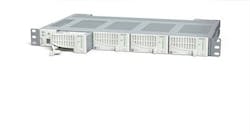Distribution shelf reduces footprint of DAS power cables
At the DAS Congress in Las Vegas (Apr. 30- May 1), GE unveiled its Power Express Class 2 distribution shelf, designed to equip wireless network providers with a solution to reduce the footprint of distributed antenna systems’ (DAS) power cables. The distribution shelf eliminates the need for installing expensive conduit to run the cables, says the company.
“Telecommunication technology advancements have led to an exponential growth in the number of sophisticated mobile devices operating across the globe. These devices provide consumers with endless communication and data tools at their fingertips; however, they also have led to concerns over how much bandwidth a wireless provider's network can facilitate,” explains Jeff Schnitzer, general manager of GE’s Critical Power business. “To address these bandwidth constraints, many telecom providers install a DAS, which increases network speed and provides bandwidth relief, but often requires costly infrastructure be installed to harness power cables. GE’s new Power Express Class 2 distribution shelf provides telecom companies with an advanced solution to combat this problem.”
See also: DAS installation case study looks at Tampa's convention center, stadium
According to GE, the Power Express Class 2 distribution shelves enable power-feed cables to be harnessed in existing infrastructure throughout a commercial building’s data cable raceway. To do this, the distribution modules located on the shelf limit individual circuit outputs to an inherently safe level by taking an input of -48 volt DC power from a battery plant and outputting it in 32 discrete 100-watt circuit cables (levels comparable to a LAN or USB data cable).
The shelf incorporates internal circuit fusing to the distribution modules, which prevents technicians from installing a higher rated fuse and violating National Electric Code (NEC) Class 2 circuit requirements. This guarantees Class 2 circuit performance and inherently ensures a safe power connection. Per NEC regulations, Class 2 compliance requires that a maximum power output be equal to or less than 100 watts per component. Class 2 circuits are considered to be safer than many others.
“By delivering an inherently safe power cable complying with the National Electrical Code, the Power Express enables the wireless service provider to run through power cables in existing data cable raceways,” concludes GE's Schnitzer.
More: Low-PIM DAS enables superior indoor wireless coverage
